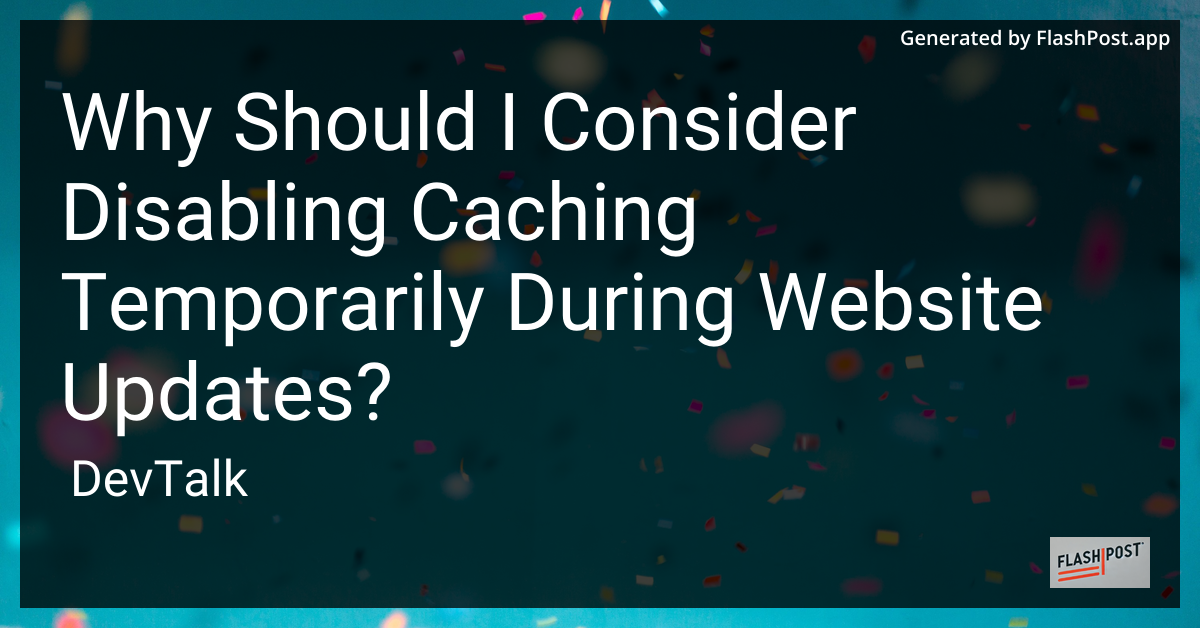Why Should I Consider Disabling Caching Temporarily During Website Updates?
 # Why Should I Consider Disabling Caching Temporarily During Website Updates?
# Why Should I Consider Disabling Caching Temporarily During Website Updates?
When making updates to your website, there's a crucial consideration that often surfaces: should you disable caching temporarily? While caching is instrumental in accelerating website performance, there are scenarios where disabling it, even if just temporarily, is beneficial.
This article explores why and how you might want to consider disabling caching during your website updates.
Understanding Caching
Before diving into reasons to disable caching, it's essential to understand what caching is. Caching is a process where previously viewed web pages are stored in a temporary storage location (the cache) to speed up future page loads. For end-users, this means faster access to web pages; for website owners, it implies less strain on the server and resources.
Reasons to Disable Caching Temporarily
1. Ensuring Fresh Content Delivery
When updating website content, such as articles, product descriptions, or even layout changes, caches can serve older, outdated versions of your pages to visitors. Disabling caching ensures that updates are reflected immediately, allowing your audience to view the latest information as soon as it is published.
2. Debugging and Testing
During website updates, especially when implementing new features or design changes, developers frequently need to test modifications in real-time. Caching can hide these changes until the cache is cleared or expires, leading to confusion and delays. Disabling caching eliminates this barrier, allowing developers to see any modifications instantaneously.
3. Validation of Functionality
If you're deploying significant changes, like new scripts or functionalities, it's critical to ensure these features work as intended across different devices and browsers. Caching can sometimes lead browsers to use outdated scripts, impeding this validation process. Disabling caching temporarily ensures that users experience the intended updates immediately.
4. Avoiding User Frustration
Nothing frustrates users more than performing an update only to find their changes don't appear due to cached content. This is particularly vital for e-commerce sites during sales, news sites covering developing stories, or any platform offering time-sensitive information. Temporarily disabling caching prevents user frustration by ensuring the delivery of current data.
How to Disable Caching
Disabling caching can be done in various ways, depending on the platform and technology stack utilized. Here are some resources for different platforms:
- For WordPress caching, follow these guidelines to ensure your updates are visible without delay.
- If you're working with CakePHP, learn how to manage caching effectively during your update phases.
- For Laravel applications, see how to disable caching in Laravel to keep your application development smooth and visible.
- Widget caching in WordPress can be tricky; if you face issues, check out how to disable caching for widgets.
- Finally, for those using Nginx, consult this guide on disabling caching in an Nginx reverse proxy to ensure your server serves the latest updates.
Conclusion
While caching is an invaluable tool for improving website performance, there are circumstances where disabling it becomes necessary, such as during website updates. By temporarily turning off caching, you ensure that your updates are immediately visible to users, that debugging and testing are seamless, and that your users receive the freshest data. Always remember to re-enable caching after completing your updates to enjoy the benefits of improved speed and reduced server load.